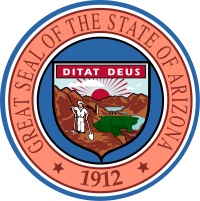- Seal of Arizona
-
The Great Seal of the State of Arizona 

Original Territorial seal
Second Territorial sealDetails Armiger State of Arizona Adopted 1912 Motto Ditat Deus
(God enriches)The Great Seal of the State of Arizona is ringed by the words “Great Seal of the State of Arizona” on the top, and 1912 the year of Arizona’s statehood. In the background is a range of mountains with the sun rising behind the peaks. At the right side of the mountains is a water storage reservoir and a dam, with irrigated fields and orchards. There are cattle grazing on the right, and a quartz mill and a miner (George Warren) with a pick and shovel on the left.
The state seal is representative of the foundational elements of the Arizona economy: cattle, cotton, copper, citrus, and climate, which are all visible on the seal. The Five Cs, as they are commonly known, appear as follows: Cattle are represented by the cow at approximately 5 o'clock. Citrus is represented by the irrigated orchard slightly left of the middle. Cotton is represented by the irrigated fields slightly right of the mid-line. Copper is represented by the miner on the left. Climate, as expressed and exported in the flora and fauna, is represented by the sun and rainclouds.
History
President Lincoln approved a bill in 1863 creating the Territory of Arizona, and appointed Richard McCormick, a businessman and journalist, as the territory's Secretary. designed a seal in 1863, which featured a bearded miner standing in front of a wheelbarrow, holding a pick, and a short-handled spade. Two bare mountains appear in the background. At the bottom was the Latin motto “Ditat Deus,” God enriches.
In response to criticism, McCormick introduced a revised, more elaborate version which included new shadowing and a small stream at the miner’s feet. The wheelbarrow and spade were replaced with a more befitting long-handled shovel, and the mountains featured a pointed peak- probably Thumb Butte, west of the capital in Prescott. The motto, “Ditat Deus”, remained in its former place. The McCormick seal was nicknamed the "baking powder seal" because it resembled the label on cans of Pioneer Baking Powder.
Members of the First Territorial Legislative Assembly approved an act, in the fall of 1864, creating a new seal and authorizing the secretary “to entrust said seal to proper parties for engraving.” The seal was to be 21⁄4 inches in diameter and feature “a view of San Francisco mountain [sic] in the distance, with a deer, pine trees, and columnar cactus in the foreground; the motto to be ‘Ditat Deus.’”
Despite the plans for a new seal, Arizona continued use the old one. McCormick, preferring his own design, took advantage of a provision of the act that allowed him to use the former seal in his official duties “until the seal authorized in this act is prepared.”
The new seal was not prepared until 1879, 15 years later. The old seal was finally retired in 1879, however it is still in use by Gila County.
The first known use of the legislatively approved territorial seal was by Secretary John J. Gosper to certify the Acts of the Tenth Territorial Legislative Assembly on March 3, 1879.
Secretaries of the territory made several variations of the legislative seal during the 30 years it was in use. In 1895 Secretary Charles Bruce added shading lines to the mountains, deer, and cactus.
A seal used by Secretary Charles Akers in 1899 brought the scene back to daylight.
In 1905 when Secretary W.F. Nichols adopted a drawing from Phoenix artist Walter Rollins. In it the deer faced left, the mountains bore more resemblance to the San Francisco peaks, the trees and cactus were more realistic, and grass grew in the foreground. This seal appeared on the original copy of the Arizona Constitution adopted in 1910.
Delegate M.G. Cunniff of Yavapai County to the Constitutional Convention submitted a proposed design to the seal by Phoenix newspaper artist E.E. Motter. A special committee of three delegates formed to consider the Motter seal, and recommended adoption of the seal in Article 22, § 20 of the Constitution, which describes the present seal.
E.E. Ellinwood of Cochise County, the committee’s chairman, explained that the committee’s aim was to “get away from cactus, Gila monsters, and rattlesnakes” and feature other industries of the state. After lengthy debate that at times wandered into other political issues, on December 9, delegates approved the new seal by a vote of 28 to 11, with 13 members absent.
It was Ellinwood who was responsible for the image of Bisbee prospector George Warren on the seal.
See also
External links
 State of Arizona
State of ArizonaPhoenix (capital) Topics Index | Climate | Delegations | Geography | History | Museums | Music | People | Transportation | Visitor Attractions
Society Culture · Demographics · Economy · Education · Politics
Regions Arizona Strip | Arizona Sun Corridor | Coconino Plateau | Colorado Plateau | Grand Canyon | Kaibab Plateau | Mogollon Plateau | Mogollon Rim | Mojave Desert | Monument Valley | North Central Arizona | Northeast Arizona | Northern Arizona | Oak Creek Canyon | Phoenix Metropolitan Area | Safford area | San Francisco Volcanic Field | Sonoran Desert | Southern Arizona | Verde Valley | White Mountains
Counties Cities Chandler | Flagstaff | Gilbert | Glendale | Kingman | Lake Havasu City | Mesa | Peoria | Phoenix | Prescott | Scottsdale | Sierra Vista | Tempe | Tucson | Yuma
Categories:- United States state seals
- Symbols of Arizona
Wikimedia Foundation. 2010.

